Ansible+Jenkins+Svn实现自动化部署
- 实验平台:CentOS6.8
- 主机使用IP: 10.113.128.120
- Jenkins版本:2.46.3
一、安装ansible
1. yum安装
yum -y install ansible
如果yum安装没有找到ansible包
使用阿里云的源
http://mirrors.aliyun.com/repo/epel-6.repo
cd /etc/yum.repo.d/
wget http://mirrors.aliyun.com/repo/epel-6.repo #下载源
2. 配置文件
cd /etc/ansible/
ll
total 28
-rw-r--r-- 1 root root 18066 Jun 2 05:49 ansible.cfg #ansible主配置文件
-rw-r--r-- 1 root root 1016 Jun 2 05:49 hosts #定义主机组
drwxr-xr-x 2 root root 4096 Jun 2 05:49 roles #定义规则
二、配置ansible
1. 为远程连接主机生成公/私钥
ssh-keygen -t rsa -P '' #-t生成密钥类似(rsa/dsa) -P提供旧密码,'' 表示没有
Generating public/private rsa key pair.
Enter file in which to save the key (/root/.ssh/id_rsa):
Created directory '/root/.ssh'.
Your identification has been saved in /root/.ssh/id_rsa.
Your public key has been saved in /root/.ssh/id_rsa.pub.
The key fingerprint is:
5b:9e:3b:b7:04:47:e8:b3:28:cd:5a:ff:5e:a3:ae:b2 root@TLCUM01
The key's randomart image is:
+--[ RSA 2048]----+
| |
| . |
| . . |
| . . |
| S = . |
| o = * |
| . * + . o |
| +...o.o . |
| . Eo+B*. |
+-----------------+
cd /root/.ssh/
ll
total 8
-rw------- 1 root root 1675 Jul 4 08:34 id_rsa #私钥
-rw-r--r-- 1 root root 394 Jul 4 08:34 id_rsa.pub #公钥
2. 写入信任文件
cat /root/.ssh/id_rsa.pub >> /root/.ssh/authorized_keys #将公钥导入authorized_keys并分发到需远程控制的服务器/root/.ssh/目录内(需新建改目录)
完成上步后:
ssh + 远程服务器IP #即可实现免密钥登入(ansible主机必须与其互通)
3.定义主机
vim /etc/ansible/hosts
[bs]
10.113.128.28
[yy]
10.113.128.196
[bb]
10.113.128.34
4. 测试
ansible 0BS -m command -a pwd
10.113.128.28 | SUCCESS | rc=0 >>
/root
ansible命令详解
ansible
Usage: ansible <host-pattern> [options]
Options:
-a MODULE_ARGS, --args=MODULE_ARGS #模块的参数,如果执行默认COMMAND的模块,即是命令参数,如:“date”,"pwd"等等
module arguments #模块参数
--ask-vault-pass ask for vault password
-B SECONDS, --background=SECONDS #后台运行超时时间
run asynchronously, failing after X seconds
(default=N/A)
-C, --check don't make any changes; instead, try to predict some
of the changes that may occur #只是测试一下会改变什么内容,不会真正去执行;相反,试图预测一些可能发生的变化
-D, --diff when changing (small) files and templates, show the
differences in those files; works great with --check
-e EXTRA_VARS, --extra-vars=EXTRA_VARS
set additional variables as key=value or YAML/JSON
-f FORKS, --forks=FORKS #并行任务数。NUM被指定为一个整数,默认是5
specify number of parallel processes to use
(default=5)
-h, --help show this help message and exit #打开帮助文档API
-i INVENTORY, --inventory-file=INVENTORY #指定库存主机文件的路径,默认为/etc/ansible/hosts
specify inventory host path
(default=/etc/ansible/hosts) or comma separated host
list.
-l SUBSET, --limit=SUBSET #进一步限制所选主机/组模式 --limit=192.168.91.135 只对这个ip执行
further limit selected hosts to an additional pattern
--list-hosts outputs a list of matching hosts; does not execute
anything else
-m MODULE_NAME, --module-name=MODULE_NAME #执行模块的名字,默认使用 command 模块,所以如果是只执行单一命令可以不用 -m参数
module name to execute (default=command)
-M MODULE_PATH, --module-path=MODULE_PATH #要执行的模块的路径,默认为/usr/share/ansible/
specify path(s) to module library (default=None)
--new-vault-password-file=NEW_VAULT_PASSWORD_FILE
new vault password file for rekey
-o, --one-line condense output #压缩输出,摘要输出.尝试一切都在一行上输出。
--output=OUTPUT_FILE output file name for encrypt or decrypt; use - for
stdout
-P POLL_INTERVAL, --poll=POLL_INTERVAL #调查背景工作每隔数秒。需要-b
set the poll interval if using -B (default=15)
--syntax-check perform a syntax check on the playbook, but do not
execute it
-t TREE, --tree=TREE log output to this directory #将日志内容保存在该输出目录,结果保存在一个文件中在每台主机上。
--vault-password-file=VAULT_PASSWORD_FILE
vault password file
-v, --verbose verbose mode (-vvv for more, -vvvv to enable
connection debugging) #详细信息
--version show program's version number and exit #输出ansible的版本
Connection Options:
control as whom and how to connect to hosts
-k, --ask-pass ask for connection password #登录密码,提示输入SSH密码而不是假设基于密钥的验证
--private-key=PRIVATE_KEY_FILE, --key-file=PRIVATE_KEY_FILE
use this file to authenticate the connection
-u REMOTE_USER, --user=REMOTE_USER
connect as this user (default=None)
-c CONNECTION, --con\=CONNECTION #连接类型使用。可能的选项是paramiko(SSH),SSH和地方。当地主要是用于crontab或启动。
connection type to use (default=smart)
-T TIMEOUT, --timeout=TIMEOUT #指定SSH默认超时时间, 默认是10S
override the connection timeout in seconds
(default=10)
--ssh-common-args=SSH_COMMON_ARGS
specify common arguments to pass to sftp/scp/ssh (e.g.
ProxyCommand)
--sftp-extra-args=SFTP_EXTRA_ARGS
specify extra arguments to pass to sftp only (e.g. -f,
-l)
--scp-extra-args=SCP_EXTRA_ARGS
specify extra arguments to pass to scp only (e.g. -l)
--ssh-extra-args=SSH_EXTRA_ARGS
specify extra arguments to pass to ssh only (e.g. -R)
Privilege Escalation Options:
control how and which user you become as on target hosts
-s, --sudo run operations with sudo (nopasswd) (deprecated, use
become)
-U SUDO_USER, --sudo-user=SUDO_USER
desired sudo user (default=root) (deprecated, use
become) #远程用户, 默认是root用户
-S, --su run operations with su (deprecated, use become)
-R SU_USER, --su-user=SU_USER #指定SU的用户,默认是root用户
run operations with su as this user (default=root)
(deprecated, use become)
-b, --become run operations with become (does not imply password
prompting)
--become-method=BECOME_METHOD
privilege escalation method to use (default=sudo),
valid choices: [ sudo | su | pbrun | pfexec | doas |
dzdo | ksu | runas ]
--become-user=BECOME_USER
run operations as this user (default=root)
--ask-sudo-pass ask for sudo password (deprecated, use become)
--ask-su-pass ask for su password (deprecated, use become)
-K, --ask-become-pass #提示密码使用sudo,sudo表示提权操作
ask for privilege escalation password
</host-pattern>
三、Jenkins
1. 官网下载jenkins
https://jenkins.io/download/ #这里我下载通用war包(在此我下的2.46.3版本2.60.1版本在tomcat下跑不起来,报错是版本有问题~)
http://mirrors.jenkins.io/war-stable/2.46.3/ #2.46.3版本的下载地址
还可以直接跑(建议使用Tomcat的方式):
改变端口再次执行,
java -jar jenkins.war --httpPort=$HTTP_PORT, 例如java -jar jenkins.war --httpPort=1080
2. 访问测试
10.113.128.120:8080/jenkins #或localhost:8080/jenkins
四.配置Jenkins
1. 配置登录
将/root/.jenkins/secrets/initialAdminPassword里的密码文件拷贝进去
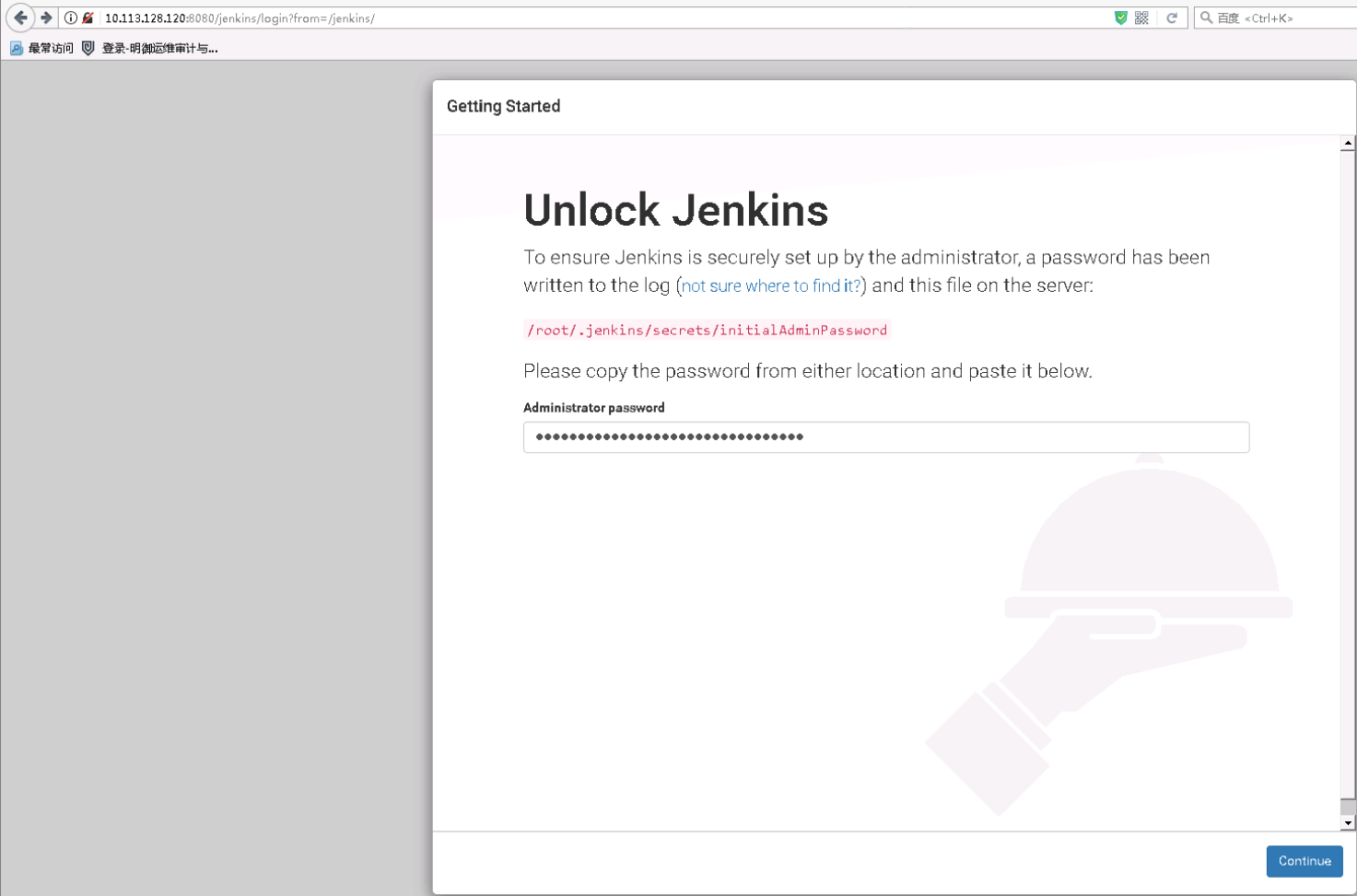
2. 选择第一个

3. 开始安装
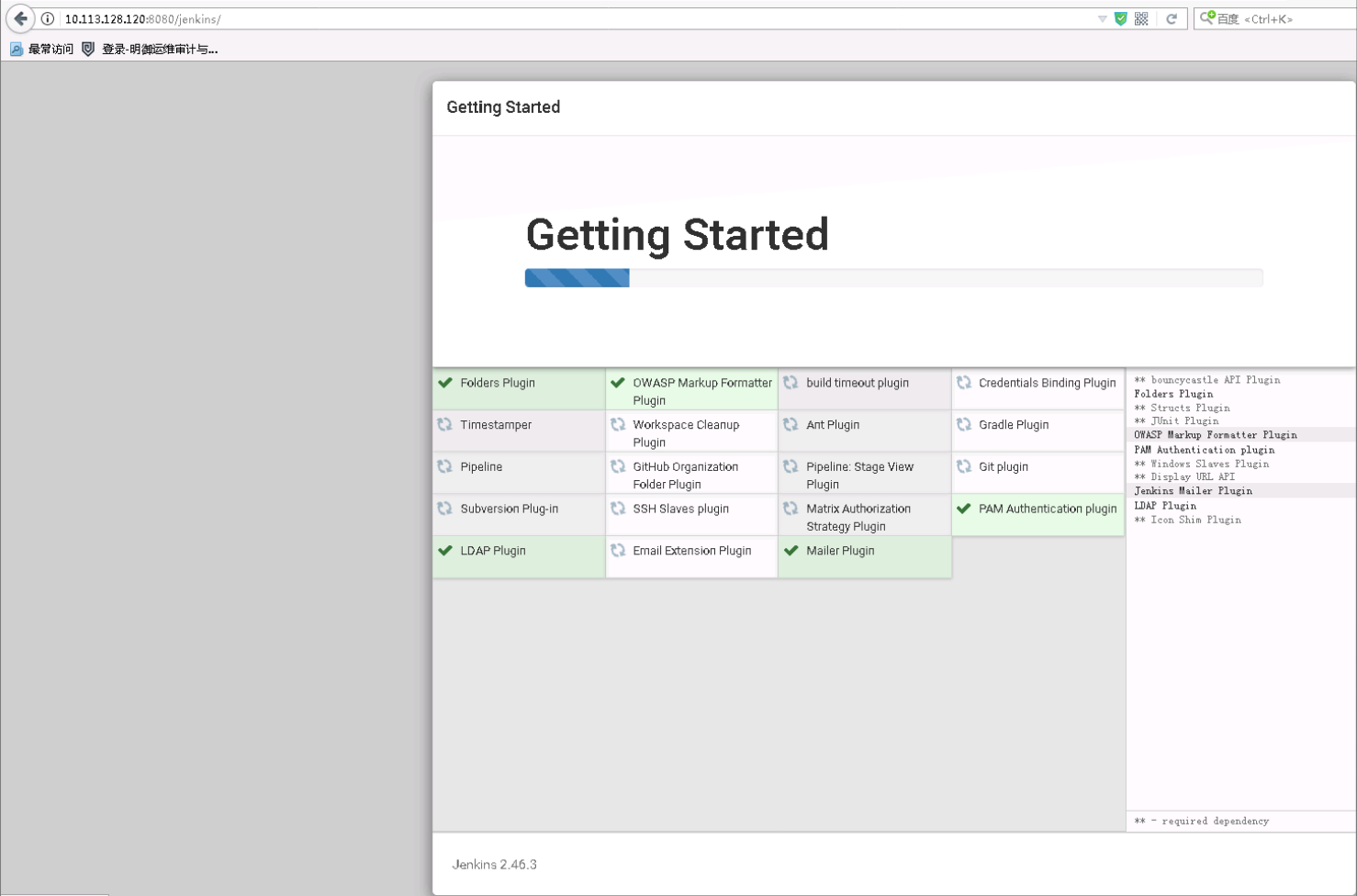
4. 配置用户信息
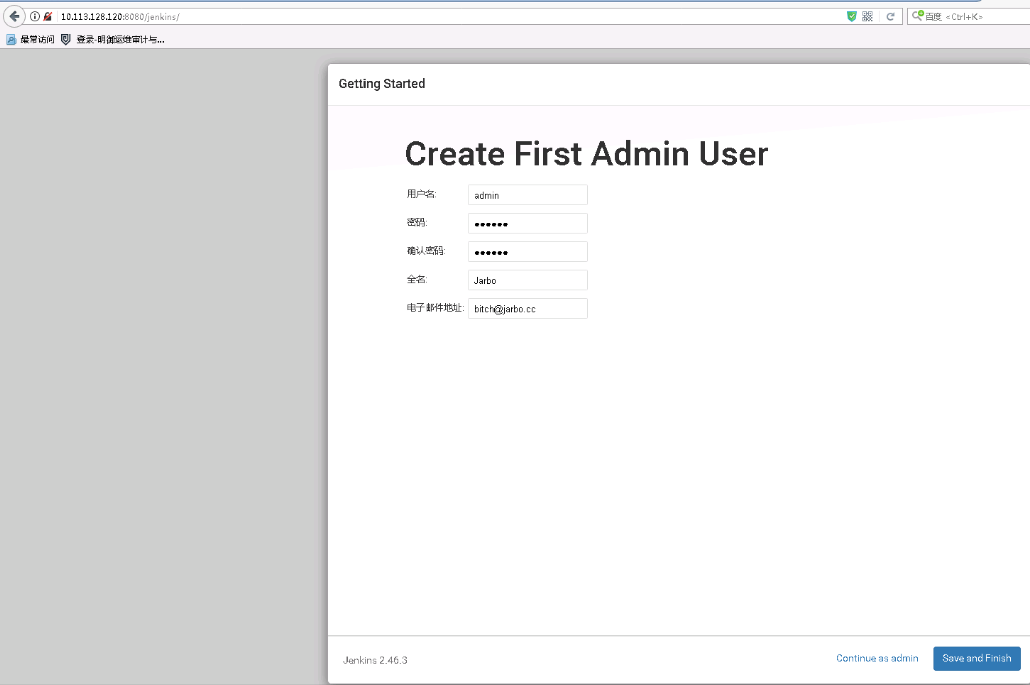
5. 安装完成
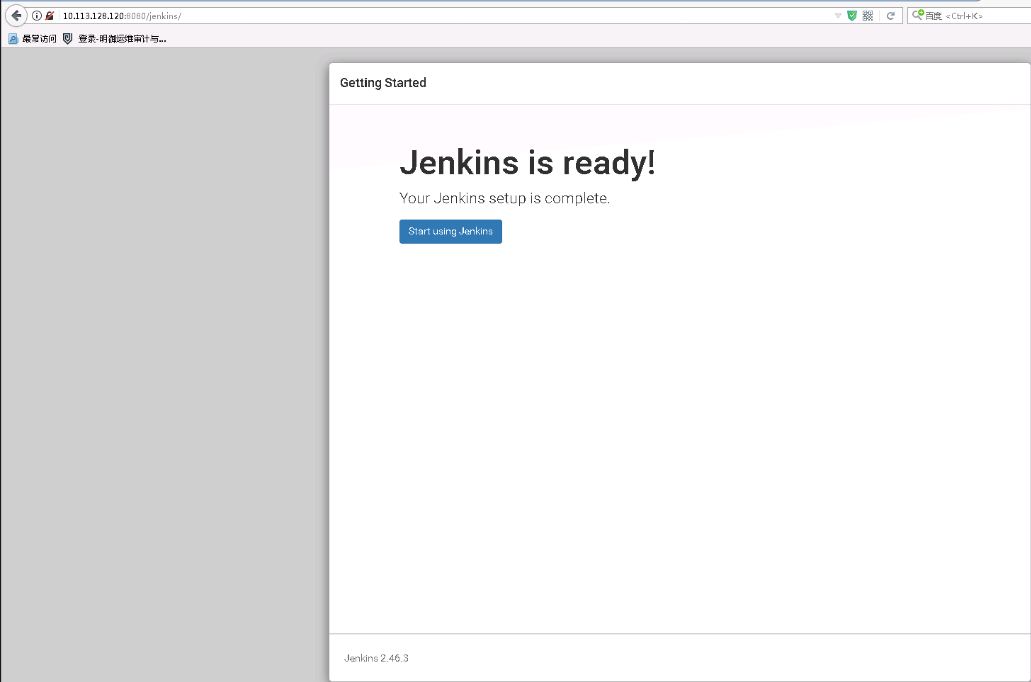
6. 测试(10.113.128.120:8080/jenkins)

五、搭建svn
1. 安装
sudo yum -y install subversion #安装svn
mkdir /ane/svn/tl -p #创建选择在var路径下创建版本库
svnadmin create /ane/svn/tl/ #在第二步建立的路径基础上,创建版本库
cd /ane/svn/tl/conf #进入配置目录
ll
authz: #负责账号权限的管理,控制账号是否读写权限
passwd: #负责账号和密码的用户名单管理
svnserve.conf: #svn服务器配置文件
vim authz #编辑
[aliases]
# joe = /C=XZ/ST=Dessert/L=Snake City/O=Snake Oil, Ltd./OU=Research Institute/CN=Joe Average
[groups]
# harry_and_sally = harry,sally
# harry_sally_and_joe = harry,sally,&joe
# [/foo/bar]
# harry = rw
# &joe = r
# * =
# [repository:/baz/fuz]
# @harry_and_sally = rw
# * = r
[\]
ane = rw #新增(ane用户读写权限)
vim passwd #编辑
[users]
# harry = harryssecret
# sally = sallyssecret
ane = redhat #给ane用户密码为redhat
vim svnserve.conf #编辑
[general]
anon-access = read
auth-access = write
password-db = /ane/svn/tl/conf/passwd #使用paswwd文件里的配置;这里要给绝对路径
authz-db = /ane/svn/tl/conf/authz #使用authz文件里的配置;这里要给绝对路径
realm = My First Repository #Svn讲解
六、构建
1. 首先配置好ansible里的规则(playbook) 进入roles
pwd
/etc/ansible/roles
mkdir tlsit #创建palybook目录(tlsit项目名称)
cd /etc/ansible/roles/tlsit/
vim bs.yml
-hosts: bs #这个是你选择的主机
roles:
-bs #这个是你下步创建的目录
NullCopy
再在bs.yml同级下创建bs文件为其添加远程构建步骤
mkdir bs
cd bs
mkdir tasks
vim main.yml
- name: del
shell: rm -rf /ane/update/*
- name: copy
copy: src=/root/.jenkins/workspace/sit-0BS/ROOT/ROOT.war dest=/ane/update/
- name: update
shell: sh /ane/script/startApp.sh
2. 进入Jenkins的主界面
点击系统管理->选择管理插件->安装Ansible plugin插件(右上角搜索),点击直接安装
3. 进入Jenkins的主界面点击新建或创建一个新任务
4. 输入项目的名字选择第一个点击OK
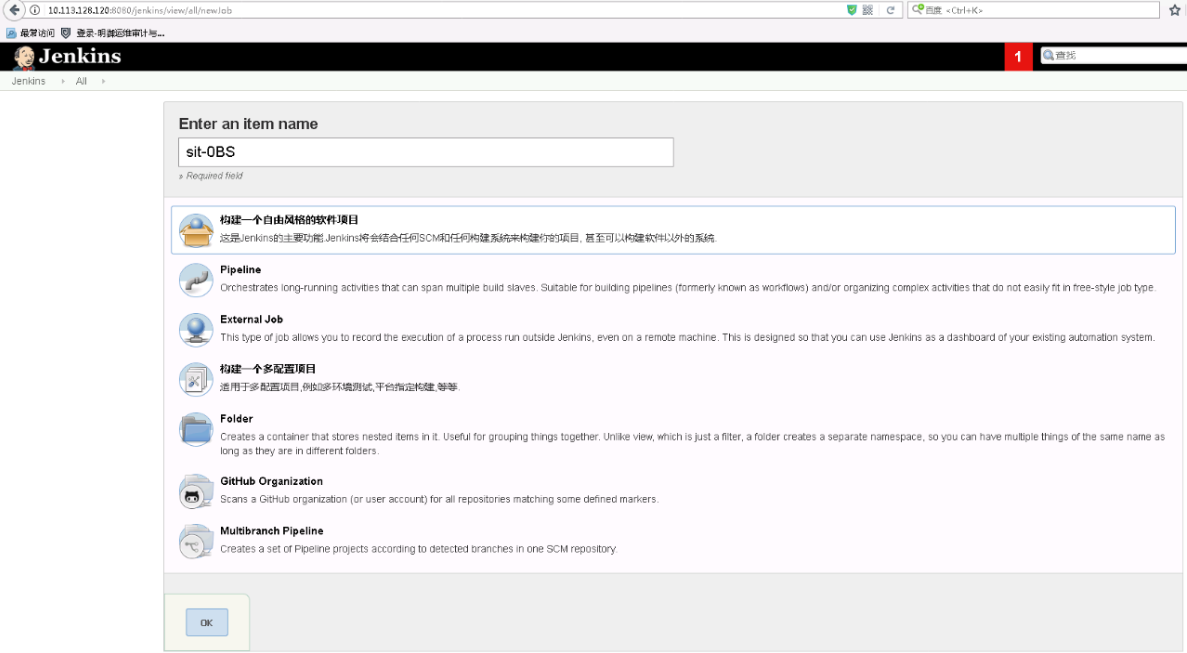
5. 选择源码管理中的Subversion(SVN) 填写第五步搭建SVN的地址(里面需要有代码)
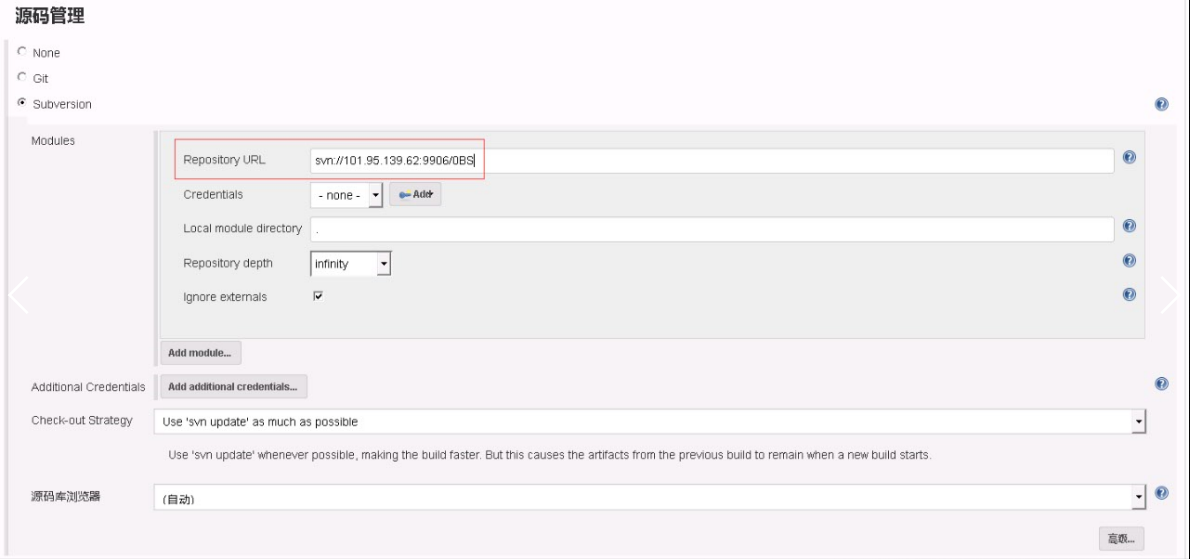
6. 选择构建 增加构建步骤 选择 Execute shell

7. 配置

8. 选择构建 增加构建步骤 选择 lnvoke Ansible Playbook

9. 配置
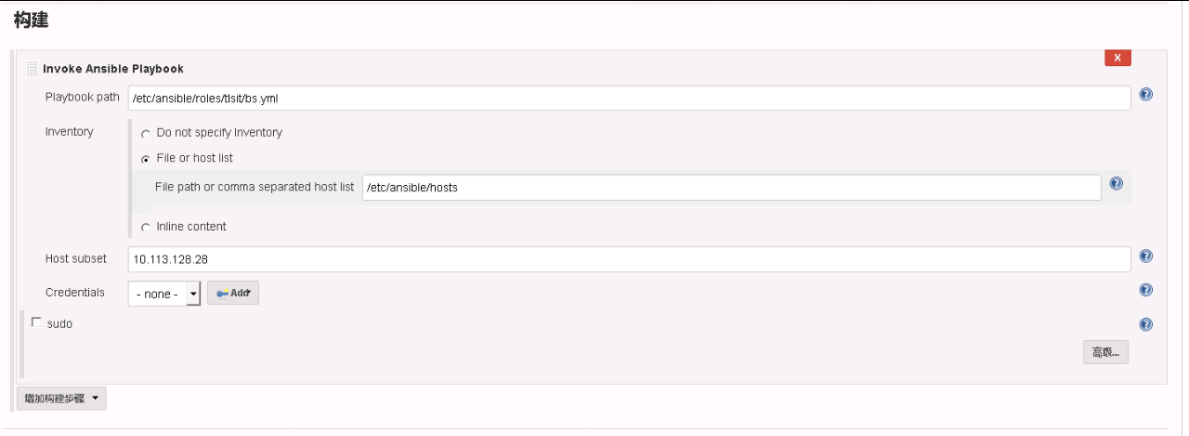
10. 点击立即构建。
蓝色–>成功
红色–>失败
白色–>为构建或取消构建
标签云
-
集群RedhatTomcatLVMLinuxAndroid部署GIT监控Postfix代理服务器WgetCurlSwiftWPSVagrantFlaskVsftpdMongodbDebianApacheTensorFlowSnmpBashVPSPuttySystemdJenkinsKloxoPHPUbuntuMacOSSambaPythonCDNiPhoneSupervisorTcpdump容器PostgreSQLShellMariaDBNginxKVMSVNCentosFirewalldDockerLUAWiresharkOfficesquidWordPressWindowsYumGoogleCactiDNSSQLAlchemyLighttpdSwarmKotlinAppleZabbixHAproxyDeepinMySQLIptablesVirtualmin缓存FlutterKubernetesNFSSecureCRTRedisSSHInnoDBIOS备份OpenStackOpenVZOpenrestyCrontabGolangSocketMemcacheAnsibleRsyncVirtualboxSaltStack